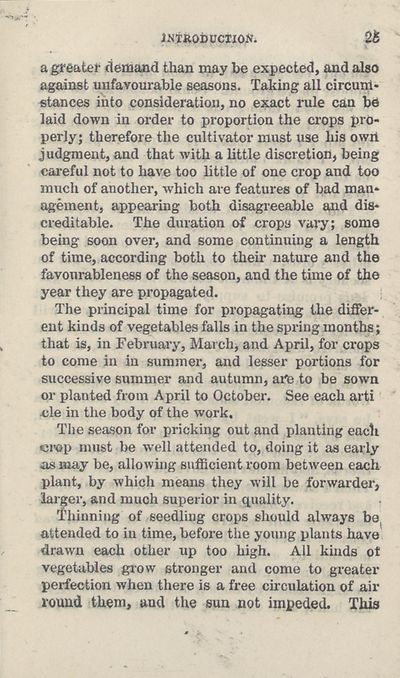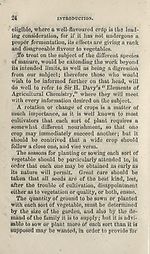Occupations > Abercrombie's improved practical gardener; with a monthly calendar for the flower garden
(29)
Download files
Complete book:
Individual page:
Thumbnail gallery: Grid view | List view

INTRODUCTION.
a greater demand than may be expected, and also
against unfavourable seasons. Taking all circum¬
stances into consideration, no exact rule can bo
laid down in order to proportion the crops pro¬
perly; therefore the cultivator must use his own
judgment, and that with a little discretion, being
careful not to have too little of one crop and too
much of another, which are features of bad man¬
agement, appearing both disagreeable and dis¬
creditable. The duration of crops vary; some
being soon over, and some continuing a length
of time, according both to their nature and the
favourableness of the season, and the time of the
year they are propagated.
The principal time for propagating the differ¬
ent kinds of vegetables falls in the spring months;
that is, in February, March, and April, for crops
to come in in summer, and lesser portions for
successive summer and autumn, are to be sown
or planted from April to October. See each arti
ole in the body of the work.
The season for pricking out and planting each
erop must be well attended to, doing it as early
as may be, allowing sufficient room between each
plant, by which means they will be forwarder,
larger, and much superior in quality.
Thinning of seedling crops should always be
attended to in time, before the young plants have
drawn each other up too high. All kinds ot
vegetables grow stronger and come to greater
perfection when there is a free circulation of air
round them, and the sun not impeded. This
a greater demand than may be expected, and also
against unfavourable seasons. Taking all circum¬
stances into consideration, no exact rule can bo
laid down in order to proportion the crops pro¬
perly; therefore the cultivator must use his own
judgment, and that with a little discretion, being
careful not to have too little of one crop and too
much of another, which are features of bad man¬
agement, appearing both disagreeable and dis¬
creditable. The duration of crops vary; some
being soon over, and some continuing a length
of time, according both to their nature and the
favourableness of the season, and the time of the
year they are propagated.
The principal time for propagating the differ¬
ent kinds of vegetables falls in the spring months;
that is, in February, March, and April, for crops
to come in in summer, and lesser portions for
successive summer and autumn, are to be sown
or planted from April to October. See each arti
ole in the body of the work.
The season for pricking out and planting each
erop must be well attended to, doing it as early
as may be, allowing sufficient room between each
plant, by which means they will be forwarder,
larger, and much superior in quality.
Thinning of seedling crops should always be
attended to in time, before the young plants have
drawn each other up too high. All kinds ot
vegetables grow stronger and come to greater
perfection when there is a free circulation of air
round them, and the sun not impeded. This
Set display mode to:
![]() Universal Viewer |
Universal Viewer | ![]() Mirador |
Large image | Transcription
Mirador |
Large image | Transcription
| Antiquarian books of Scotland > Occupations > Abercrombie's improved practical gardener; with a monthly calendar for the flower garden > (29) |
|---|
| Permanent URL | https://digital.nls.uk/121881567 |
|---|
| Description | Thousands of printed books from the Antiquarian Books of Scotland collection which dates from 1641 to the 1980s. The collection consists of 14,800 books which were published in Scotland or have a Scottish connection, e.g. through the author, printer or owner. Subjects covered include sport, education, diseases, adventure, occupations, Jacobites, politics and religion. Among the 29 languages represented are English, Gaelic, Italian, French, Russian and Swedish. |
|---|

